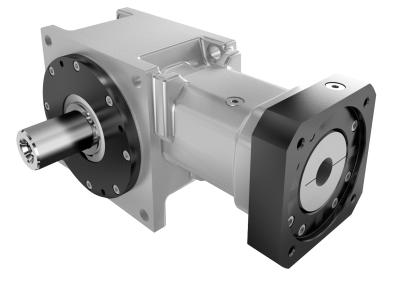
EXSYS Tool Inc. has further expanded its EPPINGER gearbox offerings to include the HT-type hypoid gearboxes that feature compact, robust designs suitable for both specific and dynamic applications. The EPPINGER HT-type hypoid gearboxes have monobloc housings that distinguish this series with enhanced stability, precision and efficiency. A highly flexible flange and coupling system enables the gearboxes to be connected to a host of servomotors without difficulty.
With solid steel alloy and hollow shafts for shrink disc connection, users can install the gearboxes in various positions with a choice of the output side. The gearboxes are available in four sizes in the ratio range from i = 5:1 to i = 15:1.
Heavy-duty bevel gears, designed and manufactured according to the Gleason process provide optimal gearing efficiency, high transmission precision and reduced load on bearings. Users also gain extremely secure torque transmission through a friction-locked, zero backlash connection of the crown gears on the drive shaft. The tooth flanks are ground to handle heavy operating demands on transmission performance at minimal tooth clearance. Such precise gear settings are achieved through constant measuring of the gear components and 100 percent test running during assembly.
In addition to extreme stability and precision, the hypoid gearbox housing offers exact positioning of the bearing seats and an integrated reinforced input neck that ensures a secure motor connection. Screw holes in the housing edges also enable a stable connection of the gearbox for various installation positions.
Steel alloy shafts with superfinished bearing seats serve as the basis for high-accuracy, heavy-duty taper roller bearings, while precise positioning at the setting of the bearings is done through the use of ground steel shims and splinting of the inner rings.
EPPINGER ensures all its hypoid gears are developed on modern GLEASON milling and grinding centers. GLEASON and ZEISS measuring machines along with GLEASON test equipment ensure each gear complies with the quality requirements of DIN 3965 and American Gear Manufacturers Association (AGMA) at all times.
Hypoid gearboxes are available with solid and hollow shaft for shrink disc connection with selectable output side. Designs with robot flange are also available upon request.
Contact Details
Related Glossary Terms
- backlash
backlash
Reaction in dynamic motion systems where potential energy that was created while the object was in motion is released when the object stops. Release of this potential energy or inertia causes the device to quickly snap backward relative to the last direction of motion. Backlash can cause a system’s final resting position to be different from what was intended and from where the control system intended to stop the device.
- centers
centers
Cone-shaped pins that support a workpiece by one or two ends during machining. The centers fit into holes drilled in the workpiece ends. Centers that turn with the workpiece are called “live” centers; those that do not are called “dead” centers.
- clearance
clearance
Space provided behind a tool’s land or relief to prevent rubbing and subsequent premature deterioration of the tool. See land; relief.
- gang cutting ( milling)
gang cutting ( milling)
Machining with several cutters mounted on a single arbor, generally for simultaneous cutting.
- grinding
grinding
Machining operation in which material is removed from the workpiece by a powered abrasive wheel, stone, belt, paste, sheet, compound, slurry, etc. Takes various forms: surface grinding (creates flat and/or squared surfaces); cylindrical grinding (for external cylindrical and tapered shapes, fillets, undercuts, etc.); centerless grinding; chamfering; thread and form grinding; tool and cutter grinding; offhand grinding; lapping and polishing (grinding with extremely fine grits to create ultrasmooth surfaces); honing; and disc grinding.
- milling
milling
Machining operation in which metal or other material is removed by applying power to a rotating cutter. In vertical milling, the cutting tool is mounted vertically on the spindle. In horizontal milling, the cutting tool is mounted horizontally, either directly on the spindle or on an arbor. Horizontal milling is further broken down into conventional milling, where the cutter rotates opposite the direction of feed, or “up” into the workpiece; and climb milling, where the cutter rotates in the direction of feed, or “down” into the workpiece. Milling operations include plane or surface milling, endmilling, facemilling, angle milling, form milling and profiling.

